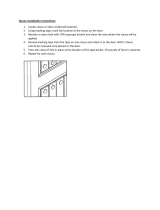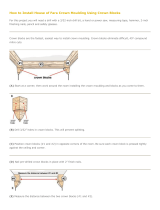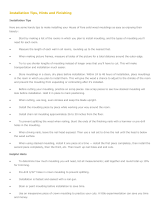
Guía de Instalación y Acabado
¿Qué Herramientas Necesito para Instalar Molduras?
• Cuchilloparausogeneral
• Rellenoparademadera,
masillaypegamento
• Escalera
• Gafasdeseguridad
• ProtecciónparalosOídos
• Nivel
• Pinzas
• Cajadeingletes,sierraparacortaringleteso
sierraparaingletes
• Clavosparaacabado,SetdeClavos,yun
martilloounmartilloneumáticoBrad
• Cintamétrica
• Escuadra
• Transportador
• PlumayPapel
Estaeslalistabásicadeherramientasquenecesitaráparainstalarmolduras:
¿Cómo Manejo Paredes Largas?
Avecesesnecesarioabarcartramosmáslargosdeloqueestádisponibleensutiendalocal,cuando
estolesucedatendráquerealizarunajuntaendosmolduras.Estetipodearticulaciónsedenomina
scarf/splicejoint.Unascarf/splicejointpermitiráqueunasolapiezasesolapeconlaotramoldura
creandounapiezamáslargademoldura.Elscarf/splicejointcreaunacosturaverticalenlainsta-
laciónterminada.Serecomiendaquecoloqueelscarf/splicejointsobreunmontantedeparedpara
fuerzaadicional.
Instalelaprimeramolduracontralaparedconuningletede45gradosenelextremodelcorteenel
ladoopuestoalaesquina.Noclavedentrodelostrespiesdelscarf/splicejointenestemomento.
Midalasiguientepiezademoldura.Elsegundocorteseráelopuestodelamolduraactualmente
instaladaenlapared.Unavezqueelsegundocortesehahecho,instalelamolduraenlapared,
colocarunclavodirectamenteenelscarf/splicejoint.
¿Cómo Puedo Instalar Molduras?
Instalelasmolduraspiezaporpiezatrabajandoalrededordeelcuarto,lainstalacióndelaspiezas
máslargaprimeras.Eviteclavarunplazodedosatrespulgadasdelextremoparaevitarrajaduras.
Algunaspiezasdefundicióndemaderarequerirálaperforaciónpreviaantesdeclavar.Siusted
estaclavandoamano,asegúresedeusarunjuegodeclavosparahundirlascabezasdelclavo
ligeramentepordebajodelacaradelamoldura.
¿Cómo Puedo Lijar la Moldura?
Usandounaesponjadelijadegranoolijadegrano220montadoenunbloquedelijar,siempre
conelgranodearenadelamadera.Lijadegranomásgruesoolijarencontradelavetadela
maderadejaráestríasnasymanchasenlamadera.Untoquemuyligeroserequierecuandola
molduraseestalijado.Serecomiendaquelaarenaentrecadacapadeprimeropintura.Estelijado
livianoaseguraraunauniónfuerteentrelascapasyledaráunacabadomásno.
¿Debería de Pintar con Primer Mi Moldura?
SóloesnecesariopintarconprimerelpinomacizoPrimedFingerJoint.Lamayoríadelasmolduras
quesevendenenTheHomeDepotvienenconunPrimeraplicadodefábrica.Siustedestápintando
moldurasdepinomacizooprimadoFingerJoint,lerecomendamoscebadoconunaimprimaciónde
altacalidad.
¿Cómo Puedo Aplicar Relleno para Madera o Masilla?
Maderaomasilladerellenoseutilizapararellenarlosagujerosdelosclavos,lareparaciónde
arañazos,abolladuras,ylasarticulacionesdesigualeseningletes.Siempreuseunrellenosin
encogimientoomasilla,sigalasinstruccionesdelfabricanteparaobtenerlosmejoresresultados.
Paramoldurastingibles,userellenodemaderaquemásseajustealcolordelamaderade
sumoldura.
¿Cuándo Debo Pintar o Teñir Mi Moldura?
Siempreserecomiendateñiropintarlamolduraantesdelainstalación.Siinstalalamoldurayluego
ledalaterminación,protejalasáreascircundantesusandocintadepintores.Recuerderetirarla
cintainmediatamentedespuésdelacabadoparaevitarquelacintadañelaparedosusalrededores.
PintaresrecomendableparatodoslasmoldurasPre-Primed.Tambiénesrecomendableutilizar
doscapasdepinturaparaladurabilidadylaapariencia.Moldurasdemaderacongranosmás
pronunciadososuperciessinprimaseadaptanmejoralaslacasobarnices.Lacaobarnizrealza
labellezanaturaldelamadera.Algunostiposdemadera,comolacicutaopinomacizosepueden
teñiracualquiercolor,mientrasqueotrostiposdemoldeadodemaderacomoelrobleprestana
teñirmasoscuros.
Recomendaciones para el Acabado
Especie de Madera Laca Barniz Pintura
Fibra de madera imprimadas
X
Finger joint imprimadas
X
Roble
X X
Pino
X X
Cicuta
X X
Finger joint común
X
Arce
X X
Abeto
X X
Measure
Outside
Moulding
Inside
Mitre
Outside
Mitre
Figure 2
Figura 1 Figura 1.1
¿Qué Tipo de Moldura Necesito?
ParalasventanasylaspuertassepuedeutilizarCasing,paratechosusodeCrown,parapisosuse
Base,yparalasparedesuseChairRailoPanelMould.Puedeelegirentreunaampliavariedadde
opcionesparacualquierestiloypresupuesto.Paraobtenermásconsejossobrelaselecciónoel
diseñoconpiezasdefundición,recogerunacopiadenuestrolibrogratis“MakeandImpression
withMoulding”olapagina“ComoComprarMolduras”.
¿Cuáles Son los Cortes Básicos para Molduras?
Elcortemásbásicoparamolduraseselinglete.Lamayoríadelasmoldurasseinstalanconingletes
queformanunángulode90grados.Laprimerapiezadelamoldurasecortaconunángulode45
grados,lasegundapiezadelamolduratambiénsecortaconungradode45queformanunángulo
de90gradosalunirse.Enaplicacionesverticales(normalmenteelCasing)losángulossoncortados
enlacaradelamoldura.Enaplicacioneshorizontales(porlogeneralelBase,ChairRail,yCrown)
losángulossecortancontralacaradelamoldura.(Figura2)
¿Qué es el Afrontamiento?
Unfrenteesunaesquinainteriorendondesecortauntrozodelamolduracuadradayqueda
justamenteapretadaenlaesquina.Elladoopuestoeselprimercortecomouningleteinterior.Luego,
utilizaunasierraparaeliminarelmaterialdelamolduradejandosuperl.(Figura3)Lajuntadel
afrontamientoseadaptaráalcortecuadradodelamolduraenlapared.Elafrontamientopuedeser
unprocesoqueconsumetiempo,peroseadaptafácilmentealasesquinasquenosonde90grados
yesmuyresistentealacontracción.
¿Cómo Puedo Terminar Una Moldura Sin Esquina?
Siustednecesitahacerunaterminaciónaunamoldurasinesquinaoquenotermineenunapared,
ustedtendráquecrearunretorno.Cortalamolduraalamedidaparaterminarlapiezaconun
ángulodeinglete.Elretornosepuedecreartomandounpequeñotrozodelamolduraycortarun
ingletealapiezadesobra.Luegocortehaciaabajodelafazdelamoldura,asegurandoquela
hojasereuniráconelbordedelcortedeinglete,locualformaunapequeñapiezatriangularde
moldura.Fijelapiezaconprensasparamaderadecarpinteríayasegurequeelpegamentoenla
piezaseseque,manteniendolaspiezasjuntasconmaskingtape.
¿Qué Herramientas Necesito para Terminar las Molduras?
• Lapinturaolaca
• Paños
• Harapos
• Masillaparamadera,masillayunapistolademasilla
• Pinceles
• PapeldeLija220
Figura 2
Figura 3
Measure
Outside
Moulding
Inside
Mitre
Outside
Mitre
Consejo Útil
Usandounasierraparaingletesyunapistoladeclavosneumáticanosóloharáelprocesode
instalaciónmásfácil,sinoquetambiénaceleraráeltiemponecesarioparalainstalación.Sino
posee,niquierecomprarestasherramientas,sepuedenalquilarenelCentrodeAlquilerdeHome
DepotCenter.
Advertencia de Seguridad
Usesiempreprotecciónparalosojos,oídosyrespiraciónalhacercualquierproyectodemejoras
paraelhogar.Recuerdelaseguridadprimero.
¿Cuánta Moldura Necesito?
Paradeterminarlacantidaddepiezasdemoldurasquenecesitaparasuproyectosigaestospasos:
1.Dibujeunplanodesuhabitación.(Figura1)
2.Midacadaparedytomenotaensuplan.
3.Tambiéntengaencuentalaubicaciónyeltamañodetodaslaspuertas,ventanasoaberturasen
lahabitación.Tambiénserecomiendaqueidentiquecadaesquinaysuángulo.(Figura1.1)
4.Añadatodaslaslongitudesdelaparedparaobtenerlacantidaddepiezasdefundiciónque
ustednecesitacomprar.Añada15%paraerroresylosresiduos.
Consejo Útil
Parasolucionarlasdecienciaslevesenlasesquinasexteriores,llenarlosvacíosconpegamento
demaderadecarpintería,yfroteladiferenciaconelladodeuncuchillo.Estoharáquelasbras
quebradasdemaderallenenlabrecha.
Consejo Útil
Siustedesdiestro,esmásfácildeinstalarpiezasdefundiciónalaizquierda.Siustedeszurdo,
esmásfácilparainstalarmoldurasdesdeelladoderecho.Deestamaneraustedpuedeapoyar
lamolduraconlamanosinfavorecidaseimpulsarlossujetadoresconsumanodominante.
Para obtener más información, visite www.homedepot.com/moulding






